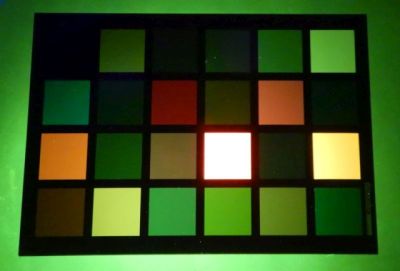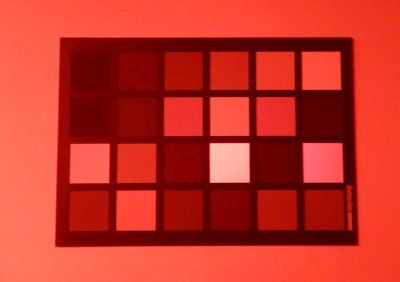Hi Jolyon and Cedric,
Just a note to consider that colour charts have strongly fluorescing panels. This means that relative to other panels, their appearance in the picture, and their reflectance measured with a spectroradiometer, will be dependent on the illuminant. The pictures below demonstrate this using a SpyderCheckr24 but the same is true for x-rite colorchecker. The first picture uses a blue light source with a yellow filter, the second a green light with a red filter (no white balance on the pictures). The panel at Col 4,Row 3 is particularly fluorescent, but others are also fluorescent to a lesser degree. I have yet to find colour standards that do not fluoresce (including Munsell chips!). This is unlikely to cause any problem for terrestrial pictures, but I can see this influencing the calibration of underwater pictures, especially below a certain depth when using natural illumination (e.g., > 10 m). A simple solution may be to first identify the fluorescent panels and exclude them from the calibration.


Cheers,
Pierre-Paul
Hi Pierre-Paul,
Do you happen to have the spectral reflectance chart for SpyderCheckr24? Could you share it with me?
Thanks,
Akhil
Hi Pierre-Paul,
Thanks so much for testing this out and flagging the issue! I’ve only used UV dark-lights to test X-Rite charts using subjective human-vision (and decided nothing was detectably fluorescent), but I haven’t tested them properly. For now, I guess we should recommend the chart-based technique should only be used with natural terrestrial light, or the same light used for the photography. I measured the charts I’ve got using direct sunlight to control for any effects like this, but you’re right about highly modified natural light (such as underwater).
Cheers,
Jolyon
